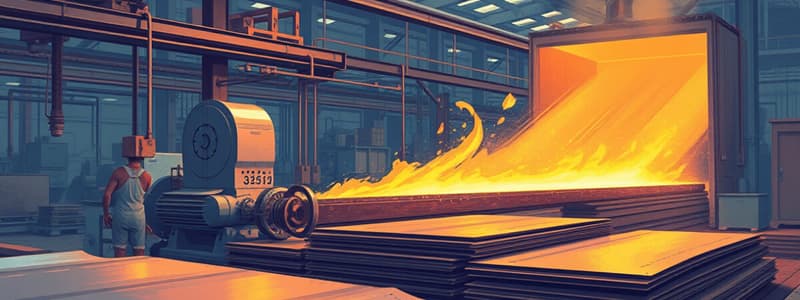Podcast
Questions and Answers
What is the main method used for manufacturing CR plates?
What is the main method used for manufacturing CR plates?
- Forging
- Hot Rolling
- Milling
- Cold Rolling (correct)
Which process is used to relieve internal stresses after cold rolling?
Which process is used to relieve internal stresses after cold rolling?
- Bending
- Tempering
- Quenching
- Annealing (correct)
What material property is primarily enhanced in cold rolled plates compared to hot-rolled steel?
What material property is primarily enhanced in cold rolled plates compared to hot-rolled steel?
- Lower Density
- Ductility
- Yield Strength (correct)
- Thermal Conductivity
Which application does NOT typically utilize cold rolled plates?
Which application does NOT typically utilize cold rolled plates?
What is one advantage of the surface finish of cold rolled plates?
What is one advantage of the surface finish of cold rolled plates?
In which industry are CR plates commonly used for body panels?
In which industry are CR plates commonly used for body panels?
What characteristic of cold rolled plates allows for easy forming and welding?
What characteristic of cold rolled plates allows for easy forming and welding?
What typically characterizes the thickness tolerances of cold rolled plates compared to hot-rolled steel?
What typically characterizes the thickness tolerances of cold rolled plates compared to hot-rolled steel?
Flashcards are hidden until you start studying
Study Notes
CR Plate
Manufacturing Process
- Cold Rolling: The primary method for manufacturing CR plates involves cold rolling, where hot-rolled steel is processed at room temperature.
- Thickness Reduction: The steel sheets are passed through rollers to reduce thickness and improve surface finish.
- Annealing: Post cold rolling, the plates may undergo annealing to relieve internal stresses and enhance mechanical properties.
- Surface Treatment: Processes such as pickling and coating may be applied for corrosion resistance and improved surface characteristics.
- Cutting and Finishing: Plates are cut to specified dimensions and finished with additional treatments as needed.
Material Properties
- High Strength: Cold rolled plates exhibit enhanced yield strength compared to hot-rolled steel.
- Surface Finish: They have a smoother surface finish, which is advantageous for paint adhesion and aesthetic applications.
- Formability: Good ductility allows for easy forming and welding processes.
- Thickness Tolerances: Generally possess tighter thickness tolerances than hot-rolled counterparts.
- Chemical Composition: Typically made from low to medium carbon steel, which contributes to their strength and hardness.
Applications in Industry
- Automotive Industry: Used for body panels, structural components, and chassis fabrication due to strength and weight considerations.
- Construction: Ideal for structural applications, such as beams and columns, where strength is essential.
- Home Appliances: Widely employed in manufacturing appliances like refrigerators and washing machines due to aesthetic and durability requirements.
- Sheet Metal Fabrication: Commonly utilized in the production of various metal components through processes like stamping and bending.
- Furniture Manufacturing: Used in the production of metal furniture and fixtures, benefiting from their durability and finish.
CR Plate Manufacturing Process
- Cold rolling processes hot-rolled steel at room temperature, enhancing the steel's properties.
- The thickness of steel sheets is reduced by passing through rollers, resulting in a refined surface finish.
- Annealing may follow cold rolling to relieve internal stresses and improve mechanical properties.
- Surface treatments like pickling and coating are applied to provide corrosion resistance and enhance the finish.
- Plates are cut to specified dimensions and can undergo further finishing processes as required.
Material Properties of CR Plates
- Cold rolled plates exhibit significantly higher yield strength than hot-rolled steel.
- They boast a smoother surface finish, which enhances paint adhesion and aesthetic appeal.
- The good ductility of CR plates ensures they are easy to form and weld.
- They typically have tighter thickness tolerances compared to hot-rolled steel.
- Made from low to medium carbon steel, contributing to the plates' strength and hardness.
Applications in Industry
- In the automotive sector, CR plates are utilized for body panels, structural components, and chassis due to their strength-to-weight ratio.
- Structural applications in construction leverage their strength for beams and columns.
- Commonly used in home appliance manufacturing, including refrigerators and washing machines, combining aesthetic appeal with durability.
- Essential in sheet metal fabrication, CR plates are produced into various components using stamping and bending techniques.
- The furniture industry benefits from CR plates in the production of durable metal fixtures and furniture pieces.
Studying That Suits You
Use AI to generate personalized quizzes and flashcards to suit your learning preferences.




